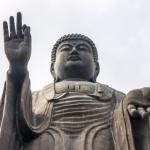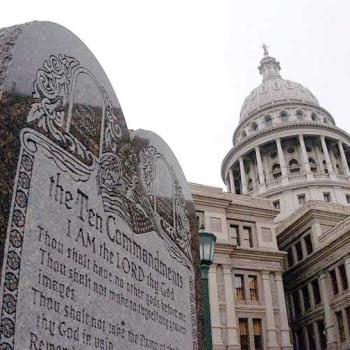The giant Buddhas of Bamiyan, central Afghanistan, were destroyed in March 2001 on orders of the leader of the Taliban. Now the Washington Post reports that the Taliban is selling tickets to view the Buddhas’ smashed remains. “Authorities have set up a ticket office at the foot of the larger of the two figures, where they charge Afghans 58 cents and foreigners $3.45 to visit,” correspondent Rick Noack writes. “Armed guards sit next to an ice cream vendor nearby. There are few customers.”
The two standing Buddhas were believed to date to the 6th century CE, give or take. The larger of the two was 180 feet (55 meters) tall. Before it was destroyed, the larger Bamiyan Buddha was the tallest stone standing Buddha in the world.
Saving the Buddhas became an international cause célèbre early in 2001, when the Taliban announced its intention to destroy the ancient relief figures. Even other Muslim countries denounced the decision. The United Nations sent letters and delegates to Afghanistan to talk the Taliban out of destroying the Buddhas. The government of India offered to take all artifacts from the site to keep them preserved. But it was no use. The Taliban considered the statues to be blasphemous. It took several attempts, but eventually dynamite brought them down.
Afghanistan is one of the poorest nations in the world, and the region around Bamiyan is among the most impoverished in Afghanistan. Since the Taliban returned to power in 2021, economic conditions have worsened. According to the United Nations World Food Program, Afghanistan is facing a food crisis. “Officials see the Buddha remnants as a potentially lucrative source of revenue and are working to draw tourism around the site,” Rick Noack writes.
The History of the Bamiyan Buddhas
The Buddha is believed to have lived in the 5th or 6th century BCE. He spent most of his life in what is now eastern India, in an area south of Nepal. By the 3rd century BCE this area was part of a vast empire that stretched east into what is now Bangladesh and west into what is now Pakistan, Afghanistan, and Iran. The emperor Ashoka the Great, a devout convert to Buddhism, ruled this empire from about 268 to 232 BCE. Ashoka introduced Buddhism into central Asia, where it flourished for several centuries. Central Afghanistan became a center of Buddhist culture.
The Silk Road, the famous network of trade routes that connected Greece and Rome to China and India, became active in the 2nd century BCE. A major route of the Silk Road went through Bamiyan, past the cliffs where the Bamiyan Buddhas would be carved in relief. By the 1st century CE Buddhist monks from central Asia were following the Silk Road merchants to bring Buddhism to China. There is no question central Asia, including Bamiyan, played a significant role in Buddhist history.
As for the Bamiyan Buddhas themselves, it’s not known who commissioned them or who sculpted them. Art historians tell us the larger Buddha represented Vairocana, the primordial Buddha from whose body all Buddhas emanate. The smaller one was Shakyamuni, which is one of the names of the historical Buddha. Stylistically, the reliefs were a fusion of Greek, Indian, and Persian influences. One of the first descriptions of the Buddhas was written by a Chinese pilgrim named Xuanzang who saw them in 630 CE. He said the Buddhas were “decorated with gold and fine jewels.” Archaeologists who have studied what’s left of the statues say they were once painted in bright colors.
Other Archeological Treasures
The Buddhas were not the only remnants of the earlier Buddhist culture in Bamiyan. The cliffs around the figures are riddled with caves. Many generations of Buddhist monks painted the caves with religious murals. Among these are the oldest known oil paintings in the world. Unfortunately much of this art has been smashed by the Taliban.
UNESCO — the United Nations Educational, Scientific and Cultural Organization — still lists Bamiyan as a World Heritage site, but its an endangered one. UNESCO warns there is a real risk of collapse of the giant niches where the Buddhas used to stand. And the damage to the mural art is irreversible.
For a time there was talk of reconstructing the two Buddhas. The statues’ fragments have been catalogued. Some attempts have been made to protect them from more damage. But with the Taliban back in control of Afghanistan, reconstruction efforts have ceased, and plans to save the site have been put on hold.
Other archeological work continues. The Chinese pilgrim Xuanzang reported that he saw a huge reclining Buddha at Bamiyan, 300 meters long. A reclining Buddha, in pieces, was discovered at the site in 2008, but this Buddha was only about 19 meters long. Researchers still hope to uncover the giant that Xuanzang saw.














